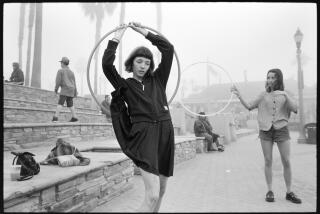To Veteran Photographer, Being Boring Is Biggest Sin
Al Belson thinks that one of the problems with photography is that it’s too easy to make a bad picture.
“All you do is stick the lens out the door, press the button and you get a bad picture,” Belson says.
A bigger problem, the Costa Mesa photographer says, is that “the level of acceptance is so low. Everybody and his brother thinks he’s a photographer.”
Belson says that because of technology, the only thing you have to worry about in photography is the subject. That, however, is the most critical element of all, the only one you can’t do without.
“When I spend time looking through students’ portfolios, or when I go to a gallery or an exhibit, I usually come up with the same word: Boring. They are boring pictures. You can study all you want and all you’re going to wind up with is a big visual vocabulary. But if you don’t have anything to say, all you’re going to say is nothing very eloquently. If you don’t have an interesting story to tell, a lot of $6 words aren’t going to help you.”
Examples of Belson’s work will be included in “A Visual Expedition: 15 Decades of Photography,” an exhibit opening Saturday and running through Aug. 18 at the Brea Civic and Cultural Center Gallery. Other photographers to be featured include Ansel Adams, Lewis Baltz, Judy Coleman, George Hurrel, Barbara Morgan and Edward Weston.
A dozen of Belson’s street photography images from London in the ‘60s, Spain in the ‘70s and Italy and Hawaii in the ‘80s will be on view. (His work is also being shown at Gianni restaurant and at the Susan Spiritus Gallery, both in the Crystal Court at South Coast Plaza in Costa Mesa.)
Belson was born in London in 1924 and says he became interested in photography because his father was an amateur photographer. “At the time, the photographer was the alchemist of the block,” Belson recalls. “It was all magic: Where is the image coming from?
“It was difficult inasmuch as everyone was compounding his own developer, getting the formulas from Kodak. You would usually have to be mixing this stuff up, while someone was trying to cook.
“I can tell you a story about early light meters,” he continues. “It sounds like something from a Jackie Gleason show. My father had a friend who used a cat in a basket as a light meter. He would take a basket with him that was lined in black and had a lid on it. Like Little Red Riding Hood.
“In there was his cat. When he wanted to take a picture, he would open the basket, take the cat out, look at the cat’s face and by the size of the pupil of the cat’s eye he knew what the exposure would be. If the cat’s eye would be wide open, it would be f/4, and if it looked like a little pin he would stop (the lens) down to f/16.”
Belson grew up on the east side of London, which he says was a ghetto offering only a few ways out--work as an entertainer, an athlete, a musician or a car thief.
Belson chose music, specifically the bass fiddle. At 14, he quit school and got his union card and soon was on the road with a jazz band.
“I was working at a lot of sleazy clubs on the West End in London when finally on my 18th birthday I was drafted into the Marines and served for four years. I didn’t play when I was in the Marines. I came out of the service at the end of World War II and started back into the music business, leaving England and going to the Bahamas in 1950 with a six-piece band for six months, then came to the United States.”
Belson soon started shooting photos of musicians for album covers. He became so successful that he wound up renting studio space on Sunset Boulevard (for $200 a month!) and started taking publicity shots for Hollywood stars.
The photography market soon became saturated, however, so in 1960 he moved to Las Vegas, where he supported himself as a craps dealer, taking celebrity portraits in his spare time.
“Basically I would go into the stars’ dressing rooms while they were doing the first show, and set up a backdrop and my lights. When they came back they would get showered, rested and then I would do their formal portraits. I would also do candid shots during their second shows.” The stars included Sammy Davis Jr., Don Rickles, Groucho Marx, Joan Rivers and Liberace.
Belson soon decided that he wanted to open a photography school in Southern California because he believed that most teachers couldn’t communicate with their pupils. (Belson is quick to admit that he’s probably the most opinionated person you will ever met. But it’s OK, he says, “because I’m always right.”) Belson thinks that people should enjoy learning, rather than viewing it as a chore.
“I needed an area that would support the school because I wasn’t going to come cheap. The search led me toward the Newport School of Photography. I bought it for $25,000. It was on Campus Drive in Newport Beach in an industrial complex and it included a darkroom with 16 enlargers, an office, a lecture room, gallery and studio.”
After 12 years, the lease was up, the equipment was old and Belson decided not to make a major new financial commitment. Instead, he decided to just do a little commercial work and some art photography, to lecture and to open a black-and-white lab, Al Belson Photographic Services in Costa Mesa.
Looking back, he considers a comment made by a friend’s wife to be his greatest compliment. She refused to be photographed by him because, she said, “you photograph thoughts.”
“In other words, I photograph from the inside out. Basically, I like people. I may holler and scream at them occasionally. But there are very few people I don’t like.”
“A Visual Expedition: 15 Decades of Photography” opens Saturday at the Brea Civic and Cultural Center, 1 Civic Center Circle, Brea, where it continues through Aug. 18. Hours: noon to 5 p.m. Wednesdays, Fridays and Saturdays, noon to 8 p.m. Thursdays. Admission: free. Information: (714) 990-7730.
More to Read
Sign up for The Wild
We’ll help you find the best places to hike, bike and run, as well as the perfect silent spots for meditation and yoga.
You may occasionally receive promotional content from the Los Angeles Times.







